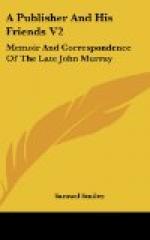A few words remain to be added respecting the statue of Lord Byron, which had been so splendidly executed by Thorwaldsen at Rome. Mr. Hobhouse wrote to Murray: “Thorwaldsen offers the completed work for L1,000, together with a bas-relief for the pedestal, suitable for the subject of the monument.” The sculptor’s offer was accepted, and the statue was forwarded from Rome to London. Murray then applied to the Dean of Westminster, on behalf of the subscribers, requesting to know “upon what terms the statue now completed could be placed in some suitable spot in Westminster Abbey.” The Dean’s answer was as follows:
The Dean of Westminster to John Murray.
DEANERY, WESTMINSTER, December 17, 1834.
DEAR SIR,
I have not had the opportunity, till this morning, of consulting with the Chapter on the subject of your note. When you formerly applied to me for leave to inter the remains of Lord Byron within this Abbey, I stated to you the principle on which, as Churchmen, we were compelled to decline the proposal. The erection of a monument in honour of his memory which you now desire is, in its proportion, subject to the same objection. I do indeed greatly wish for a figure by Thorwaldsen here; but no taste ought to be indulged to the prejudice of a duty.
With my respectful compliments to the Committee, I beg you to believe me,
Yours truly,
JOHN IRELAND.
The statue was for some time laid up in a shed on a Thames wharf. An attempt was made in the House of Commons to alter the decision of the Dean and Chapter, but it proved of no avail. “I would do my best,” said Mr. Hobhouse, “to prevail upon Sir Robert Peel to use his influence with the Dean. It is a national disgrace that the statue should lie neglected in a carrier’s ware-house, and it is so felt by men of all parties. I have had a formal application from Trinity College, Cambridge, for leave to place the monument in their great library, and it has been intimated to me that the French Government desire to have it for the Louvre.” The result was that the subscribers, in order to retain the statue in England, forwarded it to Trinity College, Cambridge, whose noble library it now adorns.
The only memorial to Byron in London is the contemptible leaning bronze statue in Apsley House Gardens, nearly opposite the statue of Achilles. Its pedestal is a block of Parian marble, presented by the Greek Government as a national tribute to the memory of Byron.
CHAPTER XXIX
BENJAMIN DISRAELI—THOMAS CARLYLE—AND OTHERS




